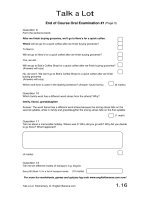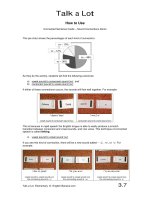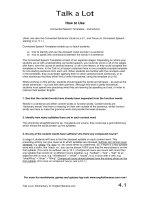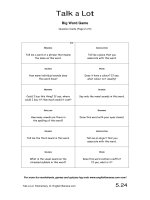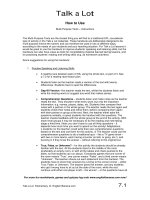Tài liệu Spoken english elementary handbook part 15 pdf
Bạn đang xem bản rút gọn của tài liệu. Xem và tải ngay bản đầy đủ của tài liệu tại đây (175.96 KB, 15 trang )
Learn the International
Phonetic Alphabet (IPA)
Contents
Why Bother Learning the International Phonetic Alphabet? 18.1
Learn the Sounds of English with the IPA – Sample Lesson Plan 18.3
The 48 Sounds of English with the International Phonetic Alphabet
18.6
Flashcards – Instructions 18.7
Flashcards 18.9
Rhyming Words – Vowel Sounds 18.19
Rhyming Words – Diphthongs 18.25
Discussion Words from Elementary Book 1 (with the IPA) 18.29
Discussion Words from Elementary Book 2 (with the IPA) 18.34
Spelling and Sounds – Consonant Clusters 18.38
Spelling and Sounds – Common Consonant Clusters (Handout)
18.46
Spelling and Sounds – Vowel Clusters 18.48
List of Vowel Clusters – In Alphabetical Order 18.55
Spelling and Sounds – Common Vowel Clusters (Handout)
18.59
Spelling and Sounds – The Magic “e” Rule 18.62
Spelling and Sounds – 250 Magic “e” Words (in Alphabetical Order)
18.64
Spelling and Sounds – 250 Magic “e” Words (Final Consonant Order)
18.65
Talk a Lot
Learn the International Phonetic Alphabet (IPA)
Why Bother Learning the International Phonetic Alphabet?
For more fun worksheets, games and quizzes log onto www.englishbanana.com now!
Talk a Lot Elementary © English Banana.com
18.1
It’s simple…
…if you can read the sounds of English with the International Phonetic Alphabet, you
will be able to correctly pronounce every single word in an English dictionary. You will
become a more independent learner, because you won’t need to rely on asking your friends
or teacher – or native speakers – “How do you say this word?” It may seem like a daunting
challenge when you first look at the chart on p.18.6, and learning the IPA will take a bit of
effort – like just about every other worthwhile activity in life – but once you’ve learned to
recognise the symbols, and which sounds they represent, you’ll remember them and be able
to use this valuable skill as you continue learning English throughout the rest of your life.
You don’t have to learn the entire IPA anyway – that’s not necessary. Just the sounds of
English, and sounds that your language has but which English does not have. The IPA covers
all of the languages of the world, but you need only focus on learning the 48 sounds of
English.
As you learn, you will better understand the differences between pronunciation in your
language and English. For example, I teach English in Poland, where all of my students
speak Polish (as you would expect). In Polish there are only 8 vowel sounds, while in English
there are 23. In Polish there are no long vowel sounds, like LìWL or L^WL and no diphthongs,
like LÉfL or L]rL. Before I began to teach the IPA in my classes, one of the most common
causes of pronunciation mistakes used to be when students tried to speak English using only
the 8 vowel sounds of Polish, instead of the 23 vowel sounds of English. Their words sounded
clipped and unnatural, without any long vowel sounds or diphthongs. They spoke like that
because that was how they understand language to be: “If it’s like that in my language, it must
be like that in English too.”
You will also be able to focus in on problem areas in your spoken English by identifying which
specific sounds you are having problems with. For example, my Polish students find the two
consonant sounds LqL and LaL really difficult, because they don’t have these sounds in
Polish. They didn’t learn to make these sounds when they first learned to speak. Furthermore,
they don’t want to stick their tongues out between their teeth when they speak, as LqL and
LaL demand! Other sounds that are difficult for them include the vowel sounds L‰WL and L¾L,
so we always spend more time practising words with these sounds.
A note about the schwa
This sound, L]L, which is called a schwa, is worth spending extra time studying, because it is
the most common sound in English. It’s the weak stress sound of the articles “a” L]L and “the”
La]L and appears in the unstressed syllables of the majority of English words with more than
one syllable. (If you don’t believe me, have a look at the Discussion Words from Books 1 and
2, from pp.18.29-18.38, and see how many schwas you can count!)
So, how do I go about learning the IPA?
If you’re learning on your own, you could use the flashcards (starting on p.18.9) to memorise
the sounds, and test yourself, as well as using the worksheets (starting on p.19.1) and tests
(starting on p.19.17) that are included in this handbook. Look online on the Talk a Lot pages
Talk a Lot
Learn the International Phonetic Alphabet (IPA)
Why Bother Learning the International Phonetic Alphabet?
For more fun worksheets, games and quizzes log onto www.englishbanana.com now!
Talk a Lot Elementary © English Banana.com
18.2
for our .mp3 file “The Sounds of English…”, on which you can hear each sound being spoken.
Learning the sounds of English with the IPA is one of the best things you could do to improve
your level of spoken English.
…or how do I teach it to my class?
You could follow the lesson plan on p.18.3 for guidance on how to introduce the sounds of
English with the IPA to a group of Elementary-Pre-Intermediate learners, and then use the
materials in this handbook to consolidate learning (see p.19.1 onwards). The IPA may not
seem like an easy topic to teach, but your students will enjoy it, and later on they’ll thank you
for covering it with them. If you give them the chance to learn the sounds of English with the
IPA, their spoken English will improve as their understanding of the language – including
stress and vowel sounds – increases. You’ll be giving them a gift that keeps on giving. A gift
that’s for life, not just for one lesson! Good luck!
Talk a Lot
Learn the International Phonetic Alphabet (IPA)
Learn the Sounds of English with the IPA – Sample Lesson Plan
For more fun worksheets, games and quizzes log onto www.englishbanana.com now!
Talk a Lot Elementary © English Banana.com
18.3
Activity Type: Introduction to the sounds of English with the IPA
Level:
Elementary - Pre-Intermediate
Skills:
Speaking & Listening; Pronunciation
Class Size:
Whole group lesson, e.g. ten students in a group
Time:
1 hour
Aim:
To introduce the sounds of English with the IPA; to lay the
foundations for further study with the IPA
Materials:
x1 IPA handout (p.18.6) per student, whiteboard and pens; students
have their notebooks and pens
Note: this lesson focuses on teaching the vowel sounds of English, with only a little focus on
the consonant sounds. This is because most of the consonant sounds can be guessed at,
because they are encountered in English already (e.g.
LÖL
,
LíL
,
LÇL
, etc.). The vowel sounds are
more difficult to learn from scratch, so we spend more time with them during this lesson,
although we do also look at some of the scarier-looking consonant sounds (e.g.
LÏL
,
LípL
,
LwL
,
etc.) towards the end of the lesson.
Procedure:
1. Give out the handouts as students come into the class. This gives them time to look at
them, comment (e.g. “On no!”), and get ready for the lesson.
2. Tell students that you’re going to learn the sounds of English with the IPA. Write on the
board:
Vowel sounds
Your language: ___
English: ___
Elicit how many vowel sounds there are in your students’ first language (or different students’
first languages for mixed nationality groups), and write it on the board. Make sure you know
that answer before the lesson, e.g. in Polish there are 8 vowel sounds. Elicit from students
how many vowel sounds there are in English (23). No doubt they will be surprised at the
disparity between the two numbers. In English there are a lot of vowel sounds! Explain that
lack of knowledge of English vowel sounds causes many mistakes in pronunciation.
3. Explain why you are doing this activity today. When I did this, I read a short text in Polish
(which my friend helped me to write, because I’m an elementary rather than fluent Polish
speaker). The text helped the students to understand the aims of the lesson. It went
something like this (in Polish):
Talk a Lot
Learn the International Phonetic Alphabet (IPA)
Learn the Sounds of English with the IPA – Sample Lesson Plan
For more fun worksheets, games and quizzes log onto www.englishbanana.com now!
Talk a Lot Elementary © English Banana.com
18.4
“If you know the phonetic alphabet, you know how to pronounce words. This alphabet gives
you power. Power!
(Here I emphasised the word “power” (“moc”) in Polish for comic effect, as well as to make my
point – “Da wam moc! Moc!”)
“You will be able to speak better in English. Polish is a phonetic language. You write like you
speak.
(Here I stopped to emphasise this important concept. I pointed out that, for example “The
letter ‘a’ in Polish is always pronounced
LôL
, and the letter “o” in Polish is always pronounced
LflL
. Pronunciation in Polish is generally easier than in English.” They students agreed. I asked
them in Polish: “Is English a phonetic language?” The students grimaced and shook their
heads, laughing, because no, of course English is most definitely not a phonetic language!)
“English is not a phonetic language. We write differently to how we speak.
(I illustrated this by writing the following words on the board: “my”, “high”, “pie” and eliciting
the pronunciations. I wrote each word phonetically and explained that in the dictionary there
are two spellings for each word. The normal spelling is usually no help at all for working out
the sound of the word. By contrast, the phonetic spelling gives us the sound of the word. You
could use more examples to show that although words can have exactly the same sounds,
the spellings can be completely different. Students sometimes ask why this is, but the
lesson’s too short to go into the answer in much detail, although you could explain that
English has developed from many different languages over hundreds of years, which has
helped to push spellings and sounds apart. See pp.18.19-18.28 for more on sounds and
spellings.)
different spellings: same vowel sound:
my Lã~fL=
high LÜ~fL=
pie Lé~fL=
“If you don’t know how to say a word, you can check in the dictionary and use the phonetic
alphabet to find out the sounds.”
4. Once everybody understands why they’re doing the lesson, write on the board:
8 short vowel sounds | 5 long vowel sounds | 10 diphthongs
Drill each group of sounds in turn. I asked my students to listen, repeat, and write notes. I
read each sound loudly and clearly four times, with students repeating each time, and writing
down notes about each sound to help them remember it. They were able to use letters from
Polish to represent each sound. Give a good, clear model of each sound, or use the .mp3 file
from the Talk a Lot website as your classroom model. Use examples of words that contain
each sound, e.g. the ones on the handout, or different words that your students will know.
Talk a Lot
Learn the International Phonetic Alphabet (IPA)
Learn the Sounds of English with the IPA Sample Lesson Plan
For more fun worksheets, games and quizzes log onto www.englishbanana.com now!
Talk a Lot Elementary â English Banana.com
18.5
Highlight sounds that are the same in your students first language and in English. For
example, the sound LL is the same in Polish and in English. In English LởõL means sock,
that we wear on a foot, whilst in Polish LởõL means juice that we drink from a bottle. Let
your students have fun and enjoy making the sounds, which may be new for many of them.
My Polish students love saying the long vowel sounds, or the guttural grunt schwa L]L (that
comes from the belly), and the classroom is filled with laughter, as well as the vowel sounds
of English!
5. Explain that diphthongs are double sounds or two sounds together. For example:
LẫL + LfL = LẫfL
Encourage students to try saying the two sounds together, getting quicker and quicker until
they arrive at the diphthong LẫfL. Show students how the mouth has to move when
pronouncing a diphthong changing from the first position (for the first sound) to the second
position (for the second sound). Spoken English is a work-out for the mouth and tongue!
6. After modelling and drilling short vowel sounds, long vowel sounds, and diphthongs, go
back to the beginning and ask your students to listen and repeat each sound (about four
times). Here you may be able to spot some errors in speaking the sounds, that you can
correct straightaway.
7. At this point I always stop and congratulate the group: Well done! You can do it. You see,
you can make all of the vowel sounds in English. You dont need to use all of these sounds in
your language, but you do need to use them all in English.
8. Spend a few minutes looking at the consonant sounds. Explain that it is most important to
be able to recognise the vowel sounds, because they are what cause the most confusion and
the greatest number of errors in pronunciation. Elicit from students by saying them out loud
with them that consonant sounds are either voiced (with voice) or unvoiced (without voice).
Two-thirds of the consonant sounds are the same in English as students would expect them
to be, whilst some are different and need closer study:
16 consonant sounds that students are likely to know and recognise already:
LL, LệL, LợL, LớL, LầL, LộL, LõL, LởL, LĩL, LờL, LùL, LóL, LồL, LọL, LẹL, and LũL
9 consonant sounds that are different from how we expect, and that need extra study:
LqL, LaL, LpL, LớpL, LL, LẽL, LwL, LầwL, and LủL
9. Take general feedback from students and answer any questions they might have. Theres
been a lot to take in! Explain that this lesson is only an introduction, that theyre not
expected to learn all forty eight sounds of English in one hour, and that you will continue to
look at the sounds of English with the IPA throughout the course. Perhaps give out one set of
flashcards (see p.18.7) to each student so that they can practise memorising the sounds of
the IPA at home.


